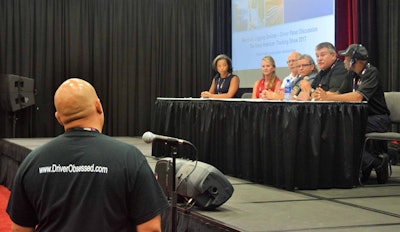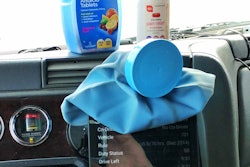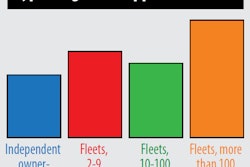 Driver Bob Stanton (second from right) responds to an audience member’s question at the GATS ELD driver panel convened by FMCSA.
Driver Bob Stanton (second from right) responds to an audience member’s question at the GATS ELD driver panel convened by FMCSA.A panel of owner-operators and drivers on the final day of the Great American Trucking Show in part illustrated a shift that’s been noted by many carriers and drivers in the past who’ve made the switch from paper logs to today’s e-log platforms for hours of service recording. Overdrive reporting on the mandate has discussed the dynamic before; it’s one encapsulated by a couple sentences in the April installment in the E-log Shift series:
The long-in-practice habit of “catching up the logbook” by drivers will mostly fall by the wayside. With no pencil to be pushed across paper, as long as the device is operational and open, duty-status changes happen with the simple push of a button in real time.
That seemingly simple change, however, is one that brings with it a raft of complications, from new administrative and operational burdens placed on drivers and carrier dispatch to the pressing need for shipper/receiver customers‘ appreciation of the new dynamics. Driver Bob Stanton, during the GATS panel convened by the FMCSA, noted that before e-logs “getting the load there on time was the first priority” for him. He’s been utilizing current-generation Automatic Onboard Recording Device (AOBRD) e-logs since 2010. Before, “you made your log look legal after” that first priority was met, he said. Now, if there’s any chance you can’t get the load there on-time within the hours rules, you need to make the appropriate calculations and stay aware of the fact well beforehand.
Customers by necessity will need to be involved, in a sense trained for new expectations. “The customer has to change their expectation,” Stanton said, who advised drivers and carriers alike to get as hard-nosed as possible with them. Whenever a situation arises where delays on the road put him behind schedule, where a reasonable expectation of load or unload times would cause him to exceed his on-duty maximum, “I document that I don’t have legal hours and stop five minutes from my customer, and we move [the pick or drop] to the morning” or pursue another fix, such as a relay.
Several audience members remarked on the uncertainty of detention timing around live-load/unload situations, which both Stanton and fellow panelist and owner-operator Charles Alexander, leased to Landstar, acknowledged as an issue. Alexander noted he’d been taking a high-touch approach with customers since his move to e-logs last year. “I like to call and let them know I’m coming,” he said. “I let them know what my hours are. I think they appreciate the fact that I let them know.” Similarly, he keeps communication lines open with the agent on the load to clue them into the extent of wait times, if any, and if there’s an issue with hours, he uses annotations within the e-log to create a record of what happened. That feature — and the reality that such annotations are then readily made available to company management — is something he appreciates about the electronic hours-recording environment.
No more “pinning everything on the driver,” Alexander said. “I can show [the issues] on the ELD,” which wasn’t necessarily the common practice on paper given logbook-catch-up dynamics. “It can create a dispute” down the line about just what happened in the event of a service failure “if I can’t show it.”
“Dealing with a live load or unload near the end of the 14-hour on-duty period” on paper logs often involved hiding time spent finding a safe place to park after the load was off and the driver was out of hours, Stanton said. With e-logs today, “the days of going in blind not knowing what you’re getting into at a live-load customer are over for me.” Stanton uses the Dock411 app/service for intel on unfamiliar shipper and receiver locations as a back-up to carrier staff and other other resources.
Speaking of parking, Owner-Operator Independent Drivers Association board member Johanne Couture, operating out of Canada and leased to a chemical-tank hauler, emphasized the issue as the “no. 1 problem in our industry,” one that in some instances no amount of planning would be able to mitigate. “I’m thinking about where I’m going to park tonight when I wake up, before I ever turn the wheel,” Couture said. “Sometimes I can utilize spots at tank-wash facilities — my first choice. … I don’t want to be the next Jason Rivenburg,” who was robbed and murdered in 2009 after having settled on a nontraditional spot. His death spurred on a grassroots movement around parking that still has energy to this day.
There are plenty of times where Couture, running Canada and the lower 48 on fairly irregular routes, has done her research,” she said. “There’s a truck stop with 150 spots” in a particular place, but “I didn’t realize everybody and their mother has a distribution center in that area.”
Attendees at the panel responded to ask panelists just what to do to avoid incriminating themselves in a situation where a search for parking — hard to come by in many areas, depending on the time of day — causes drivers to exceed daily driving or on-duty maximum limits. You can’t avoid such incrimination using an ELD, said FMCSA enforcement division specialist LaTonya Mimms. Officers will retain the discretion on whether to write a violation or not, as Overdrive has reported previously. If the time over the limits is “no more than 15 minutes,” Mimms said, the “trooper may or may not cite a nominal hours violation,” with little consequence for safety scores. In excess of 15 minutes, however, a normal violation would be the go-to mark.
Mimms and others emphasized use of annotations to any duty-status change to explain special circumstances.
Couture emphasized issues of ELD device malfunction and her frustration with getting the technology to work, generally, as well, noting at the time that she’d been utilizing an e-log for just a few weeks and “it malfunctioned three times,” she said. “I’m a target for enforcement just because of what I haul. I want 100 percent reliability. I want to be able to show the officer exactly what my hours are – that didn’t give me 100 percent reliability.”
Driver Stanton noted that hadn’t been his experience, yet emphasized the device manufacturer matters when it comes to quality. “Since 2010 I’ve had two malfunctions,” he said, “yet the equipment is from a major manufacturer. There is equipment that’s been in service since 2010 that I haven’t experienced problems with – who you shop with will be a factor.”
Couture dug in on her dislike of the change ELDs represent to her. “Depending on the manufacturer” and whether the device is an ELD or AOBRD, “you can make your own corrections” to the log if, say, you forget to go off-duty on a restroom break, for instance. For many AOBRDs, “you’ve got to make a phone call to tell the carrier you forgot to push the button to go to the washroom – it’s dehumanizing, not a good feeling. And it’s not why I got into this industry. I got into this industry for the freedom of the road. … This feels like a restriction that I don’t deserve. Part of the freedom is being minimized by having big brother watching all the time, and it’s not a feeling I enjoy.”
Attendees at the panel applauded.










